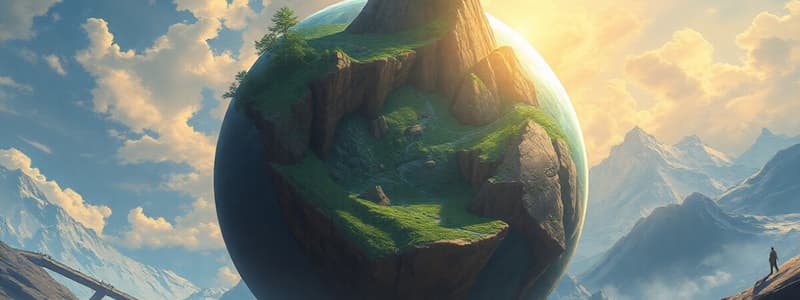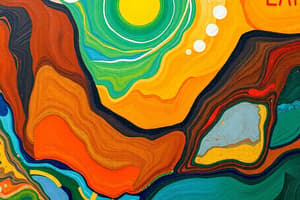Podcast
Questions and Answers
What can be a consequence of earthquakes in the ocean?
What can be a consequence of earthquakes in the ocean?
- They enhance agricultural productivity.
- They can cause a tsunami. (correct)
- They create warm water currents.
- They increase the oxygen levels in the sea.
What is the eye of a typhoon characterized by?
What is the eye of a typhoon characterized by?
- Low pressure and minimal wind speed. (correct)
- Intense lightning and thunderstorms.
- High wind speeds and heavy rainfall.
- Extreme heat and humidity.
Which property of a mineral is considered the least useful in identification?
Which property of a mineral is considered the least useful in identification?
- Luster
- Streak
- Color (correct)
- Hardness
What does the streak test of a mineral measure?
What does the streak test of a mineral measure?
What is a key advantage of Moh's Hardness Scale?
What is a key advantage of Moh's Hardness Scale?
What disadvantage does Moh's Hardness Scale have?
What disadvantage does Moh's Hardness Scale have?
Which mineral is an example of metallic luster?
Which mineral is an example of metallic luster?
Which of the following is NOT a type of non-metallic luster?
Which of the following is NOT a type of non-metallic luster?
What makes Earth the only planet capable of harboring life?
What makes Earth the only planet capable of harboring life?
What occurs if Earth is located too far from the sun?
What occurs if Earth is located too far from the sun?
In a closed Earth system, which statement correctly describes the exchange occurring?
In a closed Earth system, which statement correctly describes the exchange occurring?
Which of the following is an example of system interaction in Earth Science?
Which of the following is an example of system interaction in Earth Science?
What role does the atmosphere play in making Earth habitable?
What role does the atmosphere play in making Earth habitable?
What happens to the chemical ingredients necessary for life when Earth becomes too cold?
What happens to the chemical ingredients necessary for life when Earth becomes too cold?
Why does warm air rise and cold air sink within the Earth's atmosphere?
Why does warm air rise and cold air sink within the Earth's atmosphere?
Which factor is NOT essential for making Earth a suitable habitat for life?
Which factor is NOT essential for making Earth a suitable habitat for life?
What is the main difference between fracture and cleavage in minerals?
What is the main difference between fracture and cleavage in minerals?
Which of the following describes malleability in a mineral?
Which of the following describes malleability in a mineral?
What type of rock is formed from the hardening and crystallization of magma?
What type of rock is formed from the hardening and crystallization of magma?
What distinguishes intrusive igneous rocks from extrusive igneous rocks?
What distinguishes intrusive igneous rocks from extrusive igneous rocks?
Which describes the term 'felsic' in relation to igneous rocks?
Which describes the term 'felsic' in relation to igneous rocks?
What is the classification based on composition for igneous rocks that are dark-colored?
What is the classification based on composition for igneous rocks that are dark-colored?
What does specific gravity measure in minerals?
What does specific gravity measure in minerals?
Which mineral is known for its sectility, allowing it to be sliced by a knife?
Which mineral is known for its sectility, allowing it to be sliced by a knife?
What is stratification primarily concerned with?
What is stratification primarily concerned with?
Which of the following best describes mechanical weathering?
Which of the following best describes mechanical weathering?
Which factor is NOT relevant to mechanical weathering?
Which factor is NOT relevant to mechanical weathering?
What role do burrowing animals play in weathering?
What role do burrowing animals play in weathering?
Which mineral is specifically dissolved during the dissolution process of chemical weathering?
Which mineral is specifically dissolved during the dissolution process of chemical weathering?
What is the primary cause of hydrolysis in chemical weathering?
What is the primary cause of hydrolysis in chemical weathering?
Which process is NOT an example of an exogenic process?
Which process is NOT an example of an exogenic process?
What outcome occurs as a result of abrasion in mechanical weathering?
What outcome occurs as a result of abrasion in mechanical weathering?
What type of stress causes rocks to be pressed together?
What type of stress causes rocks to be pressed together?
Which of the following best describes the focus of an earthquake?
Which of the following best describes the focus of an earthquake?
What is the Law of Superposition related to?
What is the Law of Superposition related to?
Which dating method allows geologists to determine the relative age of fossils?
Which dating method allows geologists to determine the relative age of fossils?
What is defined as the smallest division of the geologic time scale?
What is defined as the smallest division of the geologic time scale?
During which geologic period did trilobites first appear?
During which geologic period did trilobites first appear?
Which statement about the layers C and E is true?
Which statement about the layers C and E is true?
Which of the following describes 'shear' stress?
Which of the following describes 'shear' stress?
Flashcards are hidden until you start studying
Study Notes
Earth
- Earth is the only planet in the solar system capable of supporting life due to the presence of liquid water, a suitable atmosphere, and proper distance from the sun.
- If Earth were closer to the sun, glaciers would melt, increasing sea levels and submerging continents; if farther, extreme cold could freeze life forms and oceans.
- Earth’s atmosphere serves as insulation, maintaining warmth and allowing for essential chemical ingredients for life, such as water and carbon.
Earth Subsystems
- The Earth System operates as a closed system with energy exchange but no matter exchange, receiving energy from the sun while sending some back to space.
- System interactions include volcanic eruptions affecting air quality and land, hurricanes causing coastal damage, and earthquakes leading to tsunamis and structural damage.
Minerals
- Minerals are naturally occurring, inorganic elements or compounds with defined physical and chemical properties, forming the basis of rocks and soils.
- Key properties to identify minerals:
- Color: Least reliable for identification.
- Streak: Color of the mineral’s powder.
- Hardness: Resistance to scratching, measured using Moh’s Hardness Scale, with qualitative but not quantitative limitations.
- Luster: Reflectivity of the mineral's surface, classified as metallic or non-metallic.
- Fracture vs. Cleavage: Fractures break unevenly, while cleavage breaks evenly along weak planes.
- Crystal Form: External shape of growing crystals.
- Specific Gravity: Density ratio compared to water (1 g/cm³).
- Sectility: Ability to be sliced, e.g., Gypsum.
- Tenacity: Reaction to stress; can be brittle, malleable, ductile, or flexible.
Rocks
- Rocks are solid aggregates of one or more minerals held together by chemical bonds.
- Types of rocks:
- Igneous Rocks: Form from the hardening of magma.
- Intrusive: Magma cools slowly underground, resulting in large crystals.
- Extrusive: Lava cools quickly on the surface, leading to small or no crystals.
- Igneous Rocks: Form from the hardening of magma.
Exogenic Processes
- Earth’s surface processes include weathering, erosion, and deposition.
- Weathering types:
- Mechanical (Physical): Breakdown without property change caused by pressure, temperature fluctuation, abrasion, organic activity, human activities, and burrowing animals.
- Chemical: Erosion through chemical reactions, such as dissolution of specific minerals like Halite and Calcite.
Stratification and Geological Studies
- Stratification refers to layering in sedimentary rocks; older layers are beneath younger ones (Law of Superposition).
- Fossils provide insights into past life forms, studied through relative and absolute dating techniques.
- Relative Dating: Establishes age in relation to other objects.
- Absolute Dating: Provides specific years or ranges of existence.
Geologic Time Scale
- Eons represent the largest time division, followed by eras, periods, and epochs.
- Example periods:
- Cambrian Period: Emergence of trilobites and early arthropods.
- Devonian Period: Notable developments in marine life.
Studying That Suits You
Use AI to generate personalized quizzes and flashcards to suit your learning preferences.




